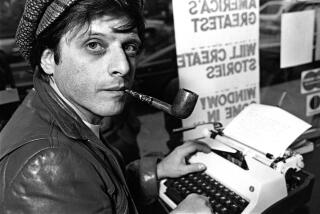No Honor in His Hometown : D.H. Lawrence: ‘He Wrote Dirty Books, Didn’t He?’
- Share via
EASTWOOD, England — Devotees of D.H. Lawrence, who wish that “Lady Chatterley’s Lover” was not his most famous book, have plunged his hometown into a three-week celebration of the centenary of his Sept. 11 birth. It is not universally popular.
Fifty-five years after he died, 25 years after British courts finally permitted “Lady Chatterley’s Lover” to be published with all the words he wrote, Lawrence is regarded as a modern master by the literary world. A plaque honoring him is to be installed in Poets’ Corner in Westminster Abbey later this year.
However, in his hometown, some residents still think of him only as a writer of “dirty books.” And some families believe they were maligned in his novels, most of which are set in the towns and rolling, wooded countryside of his native Nottinghamshire.
There was a Lawrence centenary fair and parade Sept. 7, with wildly imaginative and humorous floats, with themes from “Lady Chatterley” and other books, including “The Plumed Serpent” and “The Rainbow.” Except for two, though, the floats were made by a professional entertainment company, and the locals mostly sat on their hands.
Held at a picnic ground beside the abandoned coal mine where Lawrence’s father once worked, the fair drew about 2,000 people--a good crowd from Eastwood’s 11,000 population. Some were there, though, because it was the only fun to be had.
“What do I think of D.H. Lawrence? He wrote dirty books, didn’t he,” said a burly truck driver with tattooed forearms. “It’s like the Beatles and Liverpool--they made it and left. Lawrence made it and left Eastwood.”
Lawrence was a visionary who extolled natural sensuality and thought modern life was robbing people of the ability to experience the quality of life. He left Nottinghamshire in his 20s and lived much of his life abroad, dying of tuberculosis in France in 1930. Still, his letters show that he was eager for gossip from home, fodder for his stories.
Organizers of the festival say the older men here still looks askance at Lawrence. There is a feeling that Lawrence wasn’t a man because he hadn’t worked in the mines.
‘Judge Him on One Book’
“It’s the older generation mostly. They don’t understand him,” said Enid Goodband, a veteran struggler for this local miner’s son. “They judge him on one book, ‘Lady Chatterley,’ and it’s passed down from generation to generation. But it’s going now as the older generation dies and the new influx comes in--they’ve studied him in school.”
Goodband became interested in Lawrence during the 1959-60 obscenity trial over “Chatterley” and worked for 16 years before the town government agreed to make a museum of the tiny four-room house where David Herbert (Bert to his family) Lawrence was born Sept. 11, 1885.
The festival parade, Goodband said, was “something I dreamed of for more than 20 years.” She thought it marked a change in local attitudes but acknowledged that there is still resistance to Lawrence.
Visitors to the museum on a recent day met Lawrence’s niece, Margaret Needham, whom he called Peggy and described as having “red-gold hair in dangling curl-rags” in a letter he wrote to a friend in 1919.
Margaret Needham, now 76 and white-haired, recalled the day Lawrence wrote that letter. It was her 10th birthday, and he took her for a winter walk, astounding her by knowing which animals and birds had made which tracks in the snow.
“He was an uncle we loved very much,” she said.
Yes, she had read “Lady Chatterley’s Lover”--one Good Friday, all at once, when her parents were out.
Rejects ‘Dirty Book’ Label
“I don’t think that was his best book, and it annoys me when people say that, that people only judge him for that,” she said. “They talk about him only writing dirty books. Well, he did not.”
So why was there still resistance to Lawrence in Eastwood?
“It was because he did use certain people in Eastwood as a basis for some of his characters,” she said. “And they forgot his books were fiction, not biography, and they took exception to how they were portrayed. So it’s understandable, in a way.”
The major problem, in the eyes of the Lawrence devotees, is the Barber family, owners of the now-depleted coal mines and large farming estates that include settings for several of the novels, notably “Sons and Lovers” and Lawrence’s last novel, “Lady Chatterley’s Lover.”
May Have Been Model
If Eastwood is the setting for “Lady Chatterley,” then a Barber ancestor might have been the model for Sir Clifford, the crippled landowner who lost his wife Connie to the gamekeeper, Mellors. The Barbers still refuse all inquiries related to Lawrence.
There is another side to the “Lady Chatterley” saga, though, and one native of Eastwood was happy to claim a family tie to the novel. Eric Anderson, an art teacher, said his grandfather Tom was gamekeeper on the Barber estate at the time Lawrence lived in the area.
“It was a nice thought to think that when he wrote about the gamekeeper, well, here’s my granddad who was the gamekeeper,” Anderson said. “I just associate the two. It would be difficult to prove that it was true.”
“I don’t think people here realize what a genius he was,” Anderson said. “His descriptions mean more to me, of the fields and the woods, because I live here and can see it. . . .
“He was a man, as they’ve said, before his time, haven’t they?”
More to Read
Sign up for our Book Club newsletter
Get the latest news, events and more from the Los Angeles Times Book Club, and help us get L.A. reading and talking.
You may occasionally receive promotional content from the Los Angeles Times.









